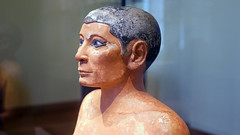

A copy is exhibited at the United Nations Headquarters in New York. The peace treaty that was eventually negotiated between the two countries is the first in human history whose texts were published by each side. 3), third ruler of the Dynasty 19, is famous for the battle of Qadesh (at the border between modern-day Lebanon and Syria), which he fought against the Hittites of Anatolia (modern Turkey) in ca. 2) were created more than 600 years after the sculpture was first carved, when Ramesses II adopted this colossus of a Middle Kingdom pharaoh and transformed it into an image of himself. 1279–1213 B.C.) The carvings now dominating the back of the statue (fig.

Description Back of the Throne The Statue Reused as an Image of Ramesses II (ca. Let’s start with the elaborate inscriptions on the back of the statue. The following text and images explain details of this history by discussing the inscriptions and changes that were made over the millennia. During the nearly four thousand years of its existence the colossus has been transported to different locations as well as reinscribed and modified to serve as an image of several later pharaohs, including the Dynasty 19 rulers Ramesses II and Merneptah. With the breast proudly lifted and the abdominal musculature contracted, this ancient ruler seems to be inhaling: he is clearly ready to burst into action. His athletic body has broad shoulders, muscular arms, and powerful knees. In his right fist – now missing – he held a piece of cloth, an accouterment of upper class Egyptians, while the left hand lies flat on his thigh. The king is represented wearing the royal headcloth (nemes) and a partly pleated kilt that is fastened by a girdle around his waist. The placement of his pyramid complex at the entrance to the Fayum Depression seems to indicate his particular interest in developing this fertile area for agriculture. Not much is known about Amenemhat II’s long reign, which seems to have been mainly peaceful, despite preserved annals that report the taking of 1500 prisoners during a campaign in the Levant. 1987–1878 B.C.) cannot be completely excluded because of the scarcity of inscribed images of that ruler. 1919–1885 B.C.), although an earlier identification as Senwosret II (ca. 1 in the "Additional Images" above) has been recently identified by style as a representation of King Amenemhat II (ca. Often created as pairs to flank the entrances to temples, or important sections of them, they served as guardians, presenting relatively accessible images of the ruler to his people.

2030–1650 B.C.) colossal statues proliferated in ancient Egypt. The timestamp is only as accurate as the clock in the camera, and it may be completely wrong.During the Middle Kingdom (ca. If the file has been modified from its original state, some details such as the timestamp may not fully reflect those of the original file.
Statue of seated scribe software#
This file contains additional information such as Exif metadata which may have been added by the digital camera, scanner, or software program used to create or digitize it.


 0 kommentar(er)
0 kommentar(er)
